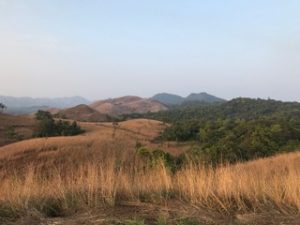Photo of the Month
September 2021
 Invasive species occupying the forest understory of Salamander park in April. This natural area in Pittsburgh, Pennsylvania is heavily invaded by Ficaria verna and Alliaria petiolata and, consequently, is depauperate of native wildflowers. Photo Credit: Rachel Reeb
Invasive species occupying the forest understory of Salamander park in April. This natural area in Pittsburgh, Pennsylvania is heavily invaded by Ficaria verna and Alliaria petiolata and, consequently, is depauperate of native wildflowers. Photo Credit: Rachel Reeb
August 2021

Prairie in the ‘Big Sky’ country at Fort Keogh Livestock and Range Research Laboratory in Miles City, Montana. Fort Keogh is used as working range, but is infested with two non-native invasive brome grasses, Bromus tectorum and Bromus arvensis (B. tectorum is the reddish-tinted grass in the picture). These non-native grasses cause major issues for ranchers in western United States, which is why they are important species of study. Photo credit: Morgan Frost.
April 2021

High altitude savanna-forest mosaics in Western Ghats, India. Photo credit: Nikunj Goel
December 2020

Upland, dry heath dominated by bell heather (Erica cinearea) and ling heather (Calluna vulgaris). Wicklow Mountains National Park, County Wicklow, Ireland. Photo credit: Lisa Kluesner.
November 2020

Submitted by William Lyons, Graduate Research Assistant and MS Student at Kentucky State University in the College of Agriculture, Community, and the Sciences. The image is from Raven Run Nature Sanctuary in Lexington, Kentucky, one of William’s study areas.
His thesis title: Accessing the Effects of Recreation Attributed Forest Fragmentation on the Spread of Invasive Species in Central Kentucky through UAV Multispectral Remote Sensing.
His project aims to (1) perform supervised classification and object based image analysis of 2019 NAIP imagery and multispectral UAV imagery to identify two endemic invasive plant species to Central Kentucky Amur honeysuckle, Lonicera maackii (Rupr.) Herder and Bradford pear, Pyrus calleryana Decne, and (2) determine the habitat attributes (slope, aspect, elevation, canopy height, and canopy density) that these species are found in abundance.
October 2020

Dead Dichrostachys cinerea following a severe drought in Kruger National Park, South Africa. D. cinerea is a prolific woody encroacher in southern African savannas but was heavily impacted by drought. Photo credit: Madelon Case, 2020 Ton Damman Award winner for best talk by a student in vegetation ecology at the ESA Annual Meeting.
September 2020

Tall cottongrass (Eriophorum angustifolium) bog grading in to a black spruce (Picea mariana) forest, Hatcher Pass, Alaska. Photo credit: Lisa Kluesner.
June 2020

Sunrise over longleaf pine (Pinus palustris) flatwoods with an understory dominated by saw palmetto (Serenoa repens). Okefenokee National Wildlife Refuge, Georgia, USA. Photo credit: Kyle Palmquist.